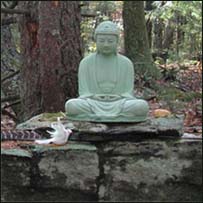|
|
 |

|

|

|
The greatest gift is the
gift of the teachings
|
|

|
| |
|
Dharma Talks
|
2016-02-04
Balanced Practice
4:31:20
|
|
| with
Kim Allen,
Richard Shankman,
Shaila Catherine
|
|
The art of Dhamma practice includes engaging skillfully with complementary aspects of practice. Sometimes we are called to actively cultivate qualities, while at other times, letting go is more appropriate. We use both our head and our heart; we engage both inwardly and in the outer world; we need both restraint and boldness. Sometimes qualities that at first appear to be in opposition, are actually inseparable -- like the front and back of a hand. This speaker series explores potential paradoxes and complimentary forces in meditation, as we learn to develop a balanced practice.
|
|
Insight Meditation South Bay - Silicon Valley
|
|
|
|
|
2016-02-04
The Unchosen Path of Illness
1:10:33
|
|
Amma Thanasanti
|
|
|
Given at Sacramento Insight Meditation. There are many challenges as well as opportunities that emerge from illness and learning how to navigate them. Dealing with expectations that practice should be different. Value of devotion, chanting and bowing. Finding different sources of energy other than will and determination. Working with emotional pain as part of the practice. Letting go of stories. Resting in awareness. Enduring overwhelm. Learning how to be OK when things are not OK.
|
|
|
2016-01-20
Impermanence
61:42
|
|
Donald Rothberg
|
|
|
Based on the earlier meditation, we examine the importance of reflection on and mindfulness of, impermanence, both gross impermanence and moment-to-moment impermanence; why it's difficult to be deeply aware of impermanence; practices to explore impermanence; and deeper understandings opened up by practices with impermanence.
|
|
Spirit Rock Meditation Center
:
Monday and Wednesday Talks
|
|
|
2016-01-19
Recollective Meditations
3:35:53
|
|
| with
Dawn Neal,
Shaila Catherine,
Tony Bernhard
|
|
The Buddha taught a broad range of meditation practice -- far more extensive than simply observing sensations and breath. Practitioners can use six classic meditation subjects to nurture calmness, focus attention, inspire patience persistence, gain confidence in the efficacy of the path, and contemplate the nature of kamma, action, and mind. The six recollections are: Buddha, Dhamma, Sangha, Virtue, Generosity, and Heavens.
|
|
Insight Meditation South Bay - Silicon Valley
|
|
|
|
|
2016-01-19
Recollection of the Buddha
48:06
|
|
Shaila Catherine
|
|
|
This is the first talk in a speaker series titled "Recollective Meditations." Shaila Catherine speaks about the meditation practice known as recollection of the Buddha, Buddhanusati. The practice involves the contemplation of qualities associated with the awakened mind. Each quality highlights a feature that the Buddha brought to perfection — in conduct, virtue, mental development, wisdom, teaching abilities, social influence, and mental powers. The reflection on these virtuous qualities of the Buddha establishes faith, confidence and inspiration for the path, deepens concentration, inhibits hindrances, strengthens joy, and refreshes the mind. It also serves as a classic protection against doubt. By contemplating the accomplishments of the Buddha, we may sense the potential for awakening within our own lives.
|
|
Insight Meditation South Bay - Silicon Valley
|
|
In
collection:
Recollective Meditations
|
|
|
|
|